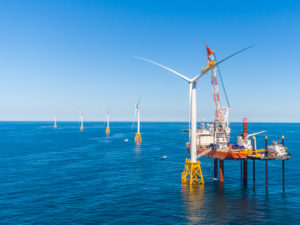
MAKING CLEAN DELIVER: Improving Clean Energy Job Quality and Growing the Clean Energy Manufacturing Supply Chain in the United States
Introduction
The United States is in the midst of a massive energy transition. The world’s leading scientific organizations have been unambiguous that climate change is a dire and urgent threat and the longer we delay the stronger the action required. Over the last decade, we have witnessed the worsening impacts a changing climate has on our communities. To avoid the catastrophic consequences of climate change, we must ensure rapid greenhouse gas emissions reductions—based on the latest science and in line with our fair share—to put America on a pathway to reduce its emissions to net zero by 2050, and to ensure we are solidly on that path by 2030.
As the nation works to drive down emissions to address the climate crisis and fights to stay competitive in the global race to develop the clean technology of the future, we can see examples of how clean energy investments can spur economic recovery, the growth of a clean economy, and high-quality job creation across the country.
For example, a heavily unionized crew of tradespeople built the Block Island offshore wind project off the coast of Rhode Island, union auto workers on factory floors across the country are building cleaner cars and trucks, and workers in St. Louis and Los Angeles are gaining access to high-skilled jobs in energy-efficiency retrofitting, pipefitting, and transit manufacturing. These are good, union jobs building and maintaining a clean energy and climate-resilient economy today.
However, too often we see that these examples have been the exception, not the rule. Importantly, clean energy workers make more than the typical worker in America. Despite this, they make less on average than workers in incumbent energy sectors because not enough good-paying, high-quality union jobs are being created in the clean energy sector. Additionally, these jobs are often not located in the same areas where other energy sector jobs are being lost or are otherwise not going to the workers and communities that need them most. [1]
As we work to meet our climate goals, we need to make a massive investment in energy efficiency and the deployment of clean and renewable technology nationwide, including low-and-no carbon electricity production; carbon capture, removal, storage, and utilization; natural ecosystem restoration; and clean, advanced, and electric transportation options. The clean energy economy already employs more than 2.8 million Americans. [2] The opportunity for job growth in these sectors is tremendous: a recent study from Princeton University’s Andlinger Center for Energy and the Environment found that the rapid deployment of climate solutions could lead to as many as 500,000 to 1 million new jobs in the U.S. over the coming decade, with net job increases projected in nearly every state. [3] At the same time, we must ensure that these investments translate into good jobs across the economy and, that in doing so, we eliminate the disparities between job quality of renewable and incumbent energy sectors. And we must ensure that we are not only creating good jobs, but accessible jobs. This includes supporting and growing pathways into good union jobs in these and other sectors for workers of color and other segments of the population historically left out of these jobs.
The good news is that we have a clear road map to achieve these goals. We can meet our clean energy deployment and climate goals while also ensuring that workers are paid fair wages, that we support and grow our domestic manufacturing supply chains, and that communities that have traditionally been left behind in our economy experience the gains in clean air, clean water, and middle-class enabling jobs. In fact, new research explored in this report verifies that increasing wages and utilization of domestic content in the clean energy sector would not appreciably increase the cost of clean energy deployment, nor extend the timeline for deploying such technology. It will, however, reap significant benefits for workers and the economy. These findings reinforce the foundation of the BlueGreen Alliance mission: we don’t have to choose between achieving our climate goals, deploying clean, affordable energy, and creating quality, family-sustaining jobs across our economy. We can and must have both at the same time.
This white paper will examine the quality of jobs in the clean energy sector and the current state of clean energy manufacturing across key clean energy sectors. It will make the case that federal policies can be enacted to ensure that jobs created across the clean energy sector—and throughout the supply chain—are high-quality union jobs and that investments made can drive growth in U.S. manufacturing, and outline how we can maximize the benefits of job growth in the clean energy sector for low-income workers and workers of color. Additionally, the report will provide a review of the new data illustrating that we can do all of this without hampering needed growth and deployment in the clean energy sector.
As we work toward a cleaner, more sustainable future, clean energy jobs are one of many important paths forward for workers. While this report will look at job quality in the clean energy sector, it does not suggest clean energy jobs are, or should be, the only path forward for current traditional energy sector workers. And it does not suggest that job quality is a problem solely in the clean energy sector. There are issues of worker misclassification and wage theft, worker health and safety, union busting, and other challenges in every sector of the economy. Workers’ rights and empowerment on the job must be protected and expanded across the economy. This report focuses narrowly on the clean energy sector, given its critical importance in the shift to a clean economy and meeting our climate goals, and lays out a case for ensuring it delivers for working people and vulnerable communities.
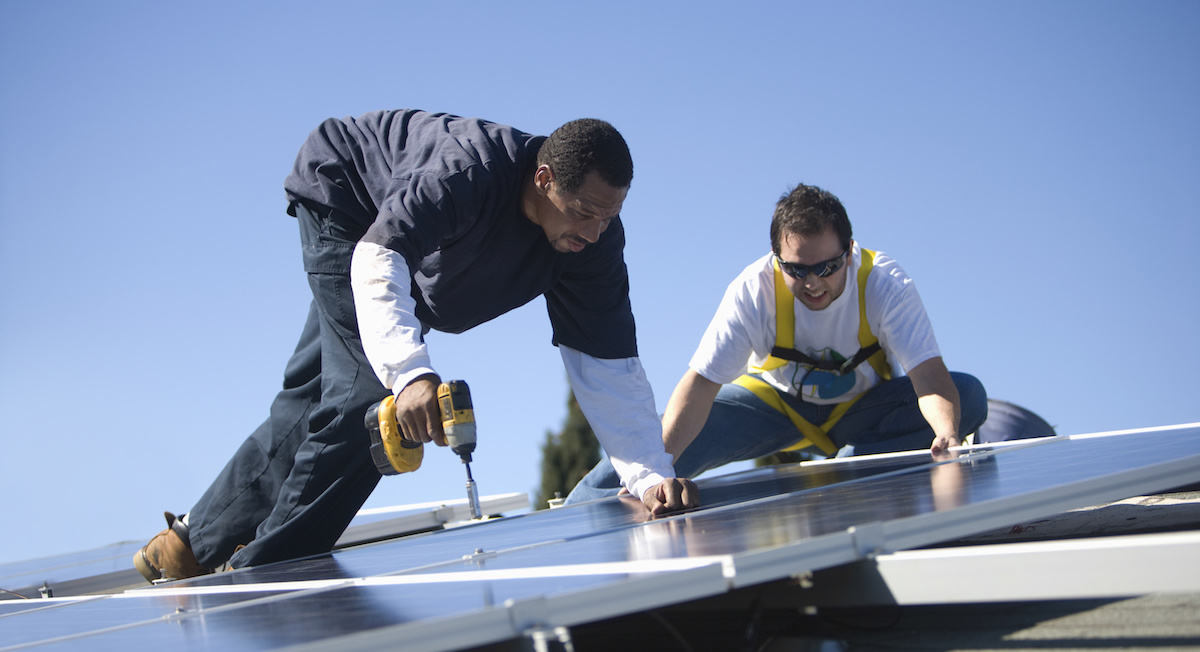
The Current Situation
Job Quality
Currently, not enough clean energy jobs compare favorably to other jobs in the energy sector. Most notably, clean energy jobs generally have lower levels of union density and wages than most traditional energy sectors.
A recent report found that clean energy jobs—defined by that report as jobs in renewable energy, energy efficiency, grid modernization and storage, clean fuels, and clean vehicles—pay 25% more than the national median wage at an average of $23.89 an hour for clean energy jobs compared with the 2019 national median of $19.24. [4] However, with 2.2 million workers in America paid the current federal minimum wage of $7.25 an hour, and nearly half of workers in America making less at $15 an hour—the proposed and long overdue increased minimum wage—such economy-wide comparisons are insufficient. [5] To get an accurate picture of how clean energy jobs stack up, we must compare them with their closest equivalents: jobs in the traditional energy sectors.
Existing data on unionization rates in the energy sector is somewhat difficult to parse., but there is ample cause for concern that emerging sectors are entrenching lower lower levels of unionization, wages, and benefits, rather than taking advantage of the opportunity to build a new generation of good energy sector jobs. However, the best survey-based data available suggests there is a gap in union density between clean energy jobs and jobs in the traditional energy sector.+
This gap is particularly concerning given that wind and solar generation, as well as energy efficiency, currently employ significantly more workers than most traditional energy generation sectors. Solar energy, with union density of 4-6%, employs 345,393 workers. Likewise, the wind generation sector employs 114,774 workers with union density of just 6%. By comparison, the nuclear generation sector employs just 60,916 workers and has a much higher union density at 12%. Coal generation employs 79,711 with a unionization rate of 10%. Again, we see natural gas fuels as an outlier with 275,924 workers and a unionization rate of just 3%.
+ The 2021 USEER reports somewhat different unionization rates than previous years, with higher unionization rates for wind and solar in particular. The difference is due to an updated methodology in the 2021 report. While the 2020 USEER based its unionization rate on surveys of employers and workers, the 2021 report uses a simple weighted average of the economy-wide unionization rates of each generation type’s major constituent industries (Construction, Wholesale Trade, Manufacturing, Professional Services, Utilities, and Other Services). This approach assumes that all types of energy workers are unionized at the same rate as all other workers in their major industry (i.e., that solar construction workers are unionized at the same rate as construction workers on any other project). This approach naturally finds that construction-intensive industries are highly unionized because the construction industry in general is more unionized than other segments of the economy. However, it cannot reveal anything specific about the unionization rate of construction workers in the energy industry, and therefore is limited in its ability to produce an accurate reflection of the real unionization rate in wind, solar, or any other energy sector.
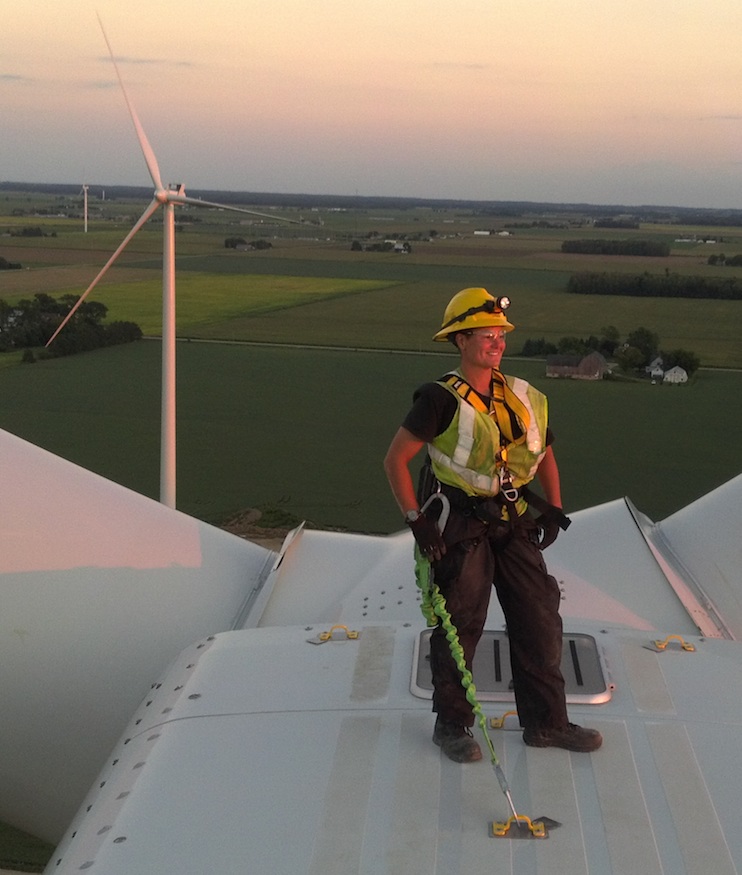
Unions at the Ready to Fill Clean Energy Jobs
As the clean energy sector grows, unions are ready to train their members for jobs in the sector. For example, the Utility Workers Union of America (UWUA) has launched a renewable energy specialist apprenticeship program called Power for America (P4A). [6] This U.S. Department of Labor (DOL) certified program provides skills training and a path to employment for workers interested in careers in the wind and solar energy generation and battery storage fields. The program provides paid, on-the-job experience, making it particularly valuable in providing pathways for low-income workers into higher skill, family-supporting careers. In fact, estimates find that a worker who has completed an apprenticeship program will earn $300,000 more over the course of their career than non-apprenticeship participants. [7]
In another example, North America’s Building Trades Unions (NABTU) and Ørsted, a global leader in offshore wind development, have launched a partnership to train workers to work on offshore wind projects. [8] Under the partnership, Ørsted will work with the building trades unions to identify the skills necessary to accelerate an offshore wind construction workforce and will develop long-term strategic plans for the development of Ørsted’s offshore wind projects. This partnership between a worldwide leader in the industry and the unions representing more than 3 million skilled craft professionals will ensure that as the offshore wind sector grows, the building and construction jobs created are good-paying, safe, accessible union jobs.
The disparity in union density is an issue because unionization is a key pathway to quality jobs and family sustaining wages. Union jobs on the whole pay better, have better benefits, and are safer than non-union jobs. [9] Across all relevant industries and occupations, workers who are members of, or are represented by, a union earn significantly more than those who are not, with especially pronounced benefits for lower-paid workers.
| Type of Worker | Average Annual Wage, Union Members | Average Annual Wage, Nonunion | Union Wage Premium, $/year | Union Wage Premium, % |
|---|---|---|---|---|
| Trades Workers, All Industries | $63,088 | 43,857 | $19,231 | 44% |
| Construction Industry, All Workers | $65,364 | 45,136 | $20,228 | 45% |
| Utilities Industry, All Workers | $75,972 | 66,196 | $9,776 | 15% |
Table A: Union membership and wage data (2019) from the Bureau of Labor Statistics News Release: Union Workers-2020. “Trades workers” refers to all construction, extraction, installation, maintenance, and repair occupations.

Union Busting in the Clean Energy Sector
For as long as unionization has been around, so has union busting. This is a problem across the economy and the clean energy sector is no exception. A recent high-profile example occurred in New York in late 2019 when a group of construction workers for Bright Power, a solar energy company in New York City, voted to form a union largely in response to ongoing workplace safety concerns. As they worked with the International Brotherhood of Electrical Workers (IBEW) to negotiate their first contract, they were all fired and Bright Power announced that they would be replaced with subcontractors. [10]
The company had previously relied on subcontractors to do their solar installation work, but hired the in-house installation team four years prior to the unionization vote. Bright Power attempted to justify their move to fire the in-house team by saying that it made “business sense” to return to a subcontractor model, as they had “spread themselves too thin,” by doing in-house work. [11] However, the company was thriving at the time, having recently been ranked by Inc. magazine as one of the 5,000 fastest growing companies in the United States. The workers, most of whom came from low-income communities of color, claim that during the union campaign management actively tried to talk them out of voting for the union. [12]
Likewise, we see that emerging clean energy-specific occupations are lower paid than traditional energy-specific occupations. Highly unionized installation, maintenance, and repair workers in the coal mining industry make a median annual wage of nearly $60,000 per year and highly unionized fossil fuel and nuclear utilities workers earn over $82,000 and $95,000 per year, respectively. Solar photovoltaic (PV) installers, in contrast, make a median annual wage of less than $45,000 (that wage does increase slightly if those workers have an electrician’s license).
It should also be noted that two of the lowest paying occupations listed in Table C—solar PV installers and wind turbine technicians—are also the two with the highest projected growth—meaning that the occupations within the energy industry that are growing the fastest are not currently producing enough good-paying jobs.ration6,360-1.3%6.0%Construction, Extrac
| Industry | Employment (Entire Industry) | Projected 2020 Growth (Entire Industry) | Union Density (Entire Industry) | Occupation | Average Annual Wage (Occupation Specific) |
|---|---|---|---|---|---|
| Nuclear Utilities | 44,366 | -0.40% | 16.80% | Construction, Extraction, Installation, Maintenance, Repair, and Production Workers | $95,861 |
| Fossil Fuel Utilities | 105,132 | -0.60% | 10.40% | Construction, Extraction, Installation, Maintenance, Repair, and Production Workers | $82,252 |
| Oil and Gas Extraction | 499,620 | 0.00% | 1.60% | Construction, Extraction, Installation, Maintenance, Repair, and Production Workers | $66,766 |
| Wind Generation | 6,360 | -1.30% | 6.00% | Construction, Extraction, Installation, Maintenance, Repair, and Production Workers | $65,645 |
| Coal Mining | 55,669 | 0.00% | 9.60% * | Construction, Extraction, Installation, Maintenance, Repair, and Production Workers | $59,469 |
| Wind | 37,910 | 3.60% | 6.00% | Wind Turbine Service Technician | $56,700 |
| Solar Generation | 3,682 | 0.90% | 4.10% | Construction, Extraction, Installation, Maintenance, Repair, and Production Workers | $53,910 |
| Solar | 183,909 | 8.30% | 4.10% | Solar Photovoltaic Installers | $46,850 |
Table B: Employment, Growth, Unionization, and Wages for fossil fuel and renewable workers in 2019. Employment and projected growth data are from the 2020 USEER and exclude manufacturing, trade, professional & business services, and other workers; unionization data is from the 2020 USEER, except for Coal Mining and Oil and Gas Extraction which are from the CPS; and wage data is from the Occupational Employment and Wage Statistics (OEWS). Note that unionization data are for a broader definition of the industry than employment and growth data. Note also that growth rates are for 2020 only, and so do not account for the increasing investment in renewables expected over the coming years.
Manufacturing Supply Chain
When evaluating clean energy jobs we must look beyond wind and solar to the manufacturer producing these products and the technology, parts, and materials that go into them. Manufacturing has long provided pathways into the middle class for millions of workers and families, and currently employs about one in 11 American workers, in addition to contributing $2 trillion a year to the gross domestic product (GDP). [13] However, the nation has lost nearly 5 million manufacturing jobs since 1997. [14] If the nation fails to make the investments needed and put in place smart policies, American manufacturing will continue to weaken. Countries around the world are rushing to capture the manufacturing and jobs benefits of the global shift to clean energy and the United States could lead the pack with the right policies in place.
Unfortunately, decades of bad policy, offshoring, and outsourcing have weakened supply chains and cost jobs, and the United States has not been taking full advantage of the opportunity to support and strengthen domestic manufacturing along that supply chain. Today, far too many of the solar panels, solar cells, electric vehicle (EV) components, and parts and materials for wind turbines that build the clean economy are manufactured overseas and shipped to the United States. [15,16,17] Steps should be taken now to rebuild those vital supply chains and grow jobs here in the United States.
The need to address these shortfalls is critical to rebuilding the American economy. Because of the failure to grow a domestic supply chain for clean energy technology, the United States is missing out on the high-quality manufacturing jobs that could be created if those items were made here.
Solar
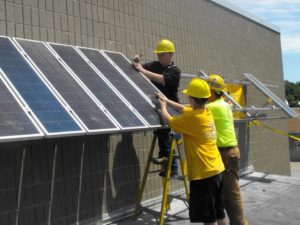
The story of the U.S. solar industry is illustrative of the consequences of the failure to act proactively in the early days of a budding industry and the need for a comprehensive, coordinated industrial policy that marries strong trade and manufacturing rules.
Until the 2000s, the U.S. was the leader in PV solar research, development, and manufacturing. [18] Then, between 2008 and 2013, as a result of solar manufacturing investment and growth in China–driven by the use of forced labor (see sidebar below)–the price of solar panels globally dropped 80%. This massive growth in China’s capacity caused a worldwide glut of solar products starting in the early 2010s, and Chinese solar panels were dumped into the U.S. market, crippling U.S. manufacturers. [19]
The nation has struggled to build back a robust solar manufacturing sector due in large part to oscillating trade policy and the lack of a consistent clean technology manufacturing strategy. Currently, there are only a small number of PV manufacturers in the United States. Most of these manufacturers are assemblers of solar panels that source solar modules, cells, and wafers from overseas. PV manufacturing remains highly dependent on foreign manufacturing, with imports satisfying about 88% of U.S. demand for solar modules in 2017. [20] Cells and modules are overwhelmingly manufactured in Asia, mainly China, South Korea, and Southeast Asia.
Over the years to come, as domestic and international demand for solar panels increases, the United States has an opportunity to expand PV manufacturing capacity in a way that provides quality, high-road jobs. With strong deployment measures, crafted hand-in-hand with deliberate manufacturing policies—including manufacturing investment incentives, measures to fill critical supply chain gaps, and a fairer trade policy—the United States can create high-quality jobs and improve our economic security at the same time.
Wind
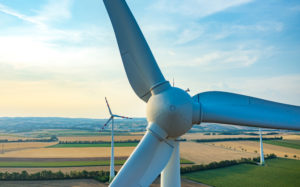
The potential for responsible offshore wind development in the United States is substantial. According to the U.S. Department of Energy, if the nation utilized even 1% of its technical potential offshore wind capacity, it could power nearly 6.5 million homes. [21] The industry is rapidly expanding both domestically and internationally.
Currently, the U.S. has just two offshore wind projects operating—the Block Island Offshore Wind Farm off the coast of Rhode Island and a small two turbine pilot project off the coast of Virginia. [22,23] However, the states of New York, New Jersey, Virginia, Massachusetts, Connecticut, Rhode Island, and Maryland have committed to buying a total of nearly 30 gigawatts (GW) of offshore wind power by 2035. [24] Estimates put job creation potential off the Atlantic Coast alone at somewhere between 133,000 and 212,000 jobs per year in the United States installing, operating, and maintaining offshore wind farms. [25] Additionally, the National Renewable Energy Laboratory (NREL) found that the Atlantic coast states could create $200 billion in new economic opportunities, as well as over 43,000 high-paying, permanent jobs, simply by developing 54 GW of their 1,283 GW offshore wind energy potential. [26]
The Block Island project was the result of years of collaboration between labor unions, environmental organizations, industry, and key government officials and entities. Its five turbines began generating power off the coast of Rhode Island at the end of 2016, and produce enough clean, local energy to power 17,000 homes. [27] The project demonstrates the diverse, highly-skilled workforce needed in the offshore wind industry. Though it is a small project, Block Island put more than 300 people to work in ten different building trades locals—working for 30 unionized contractors and subcontractors—and employed electricians, welders, ironworkers, pipefitters, pile drivers, engineers, scientists, vessel operators, lawyers, and sales representatives. [28]
However, with the exception of the foundation, all of the major parts and components of the Block Island Wind Farm were manufactured outside of the United States. The nacelles for the project came from France, the towers from Spain, and the blades from Denmark. [29] As the industry grows, sourcing components domestically represents a significant opportunity to help revitalize American manufacturing. The University of Delaware’s Special Initiative on Offshore Wind (SIOW) recent white paper predicts an almost $70 billion buildout of U.S. offshore wind supply chain by calculating growth in a number of sectors, which include wind turbines and towers; turbine and substation foundations; upland, export, and array cables; onshore and offshore substations; and marine support, insurance, and project management. [30] However, there is currently no domestic supply chain for these items, meaning that significant portions of the investment to build offshore wind projects could flow out of the economy to purchase technology manufactured abroad, rather than supporting the growth of manufacturing and jobs domestically. Imported parts and materials may also raise costs, delay installation, and complicate ongoing maintenance and repair.
High-volume domestic manufacturing, which brings down the cost, won’t happen until manufacturers see consistent demand. Strong, long-term policy that drives rapid deployment and provides investment certainty in offshore wind is necessary, coupled with policies to incentivize or require utilization of domestically-manufactured materials, to incentivize investment in establishing and expanding U.S. manufacturing facilities, and in related infrastructure like transmission. U.S. manufacturers will be able to retool and make offshore-specific products that compete with overseas manufacturers with appropriate investments and if they see long-term demand for these products. This is a huge opportunity that can be captured with the help of the right policies.
The story is brighter when looking at the onshore wind industry, though there is still room for improvement. There are currently more than 500 U.S. manufacturing facilities specializing in wind components. [31] Currently, more than 90% of nacelles—the housing for the generator, gearbox, and other mechanics—for U.S. onshore wind turbines are assembled in the United States, along with 40%-70% of blades and hubs and 65%-85% of wind towers. [32,33] However, internal nacelle components like electronics have very little domestic content. And, very few of these facilities are union represented.
Electric Vehicles

Happening alongside the nation’s transition to cleaner, cheaper forms of energy is an ongoing shift to cleaner vehicles, including EVs. The auto sector is at the heart of U.S. manufacturing, and ensuring the United States leads in EV manufacturing will be critical to sustaining good jobs in the clean economy and across the manufacturing sector. Securing jobs in the coming shift to EVs will depend equally on ensuring automakers and suppliers are building the latest and best technology here in the United States, and taking steps to reverse the outsourcing of parts and components to other nations. In short, the United States is at a crossroads and the shift to EVs can either take the nation forward—bringing manufacturing back to America and building more and better jobs—or the United States can step away from technological leadership, give back initial manufacturing and jobs gains, and put the next generation of manufacturing jobs at risk.
The quality of EV jobs varies a great deal throughout the industry. [34] Looking across the supply chain, some manufacturers in the auto sector offer wages just over minimum wage with no benefits and hazardous working conditions. Others pay workers in the $20-30 per hour range with full benefits and rigorous safety processes and oversight. Jobs in the automotive sector can either provide a ladder of training and rewarding career paths or they can be temporary and dead end jobs. There are challenges and opportunities facing workers and manufacturing in the shift to EVs and the policy action needed to ensure the ongoing shift to cleaner technology in the automotive sector also results in more and better jobs (see a backgrounder from the BlueGreen Alliance, UAW, USW and AFL-CIO Industrial Union Council for more detail here).

The Human Cost of Imports
Reliance on imported goods in the clean energy sector has been tied to human rights abuses. By producing more of these products and materials domestically and insisting on higher environmental and labor standards globally, the U.S. can ensure that they are made with high-road labor standards throughout the supply chain.
For example, American polysilicon manufacturers are currently entirely captive to Chinese wafer manufacturing, which dominates the global market, as their only customers. When China strategically decided to shut down the use of non-Chinese polysilicon in their wafer manufacturing, the U.S. suppliers were essentially frozen out of the supply chain. And it’s no better at the other end of the supply chain, where U.S. module manufacturers have no control over the materials sourcing, labor, or environmental practices behind the key components in their modules, because they have no choice but to source them from China.
Recent reporting on the substantially lower environmental, human rights, and labor standards in China show how ultimately unsustainable this arrangement is. [35] The accusations are tied to the ongoing detainment of a million or more people from minority groups in Xinjiang, namely Uighurs and Kazaks, in “re-education camps.” [36] Human rights organizations state that what they know about these abuses may be just the tip of the iceberg.
Additionally, the U.S. remains far too reliant on imports of essential metals, chemicals, and other elements needed to produce many components of clean technology, including EV batteries and solar panels. The U.S. currently lacks a consistent strategy for responsibly mining these materials at home, for developing secure and sustainable supply chains for their incorporation into the clean energy economy, and for leading by example—in cooperation with other nations that seek to mine and develop these resources in safe, environmentally responsible, and socially inclusive ways. Instead, many of these materials are mined or processed overseas—often under shockingly poor conditions and/or in ways that threaten the economic security of key supply chains. For example, the Democratic Republic of Congo produces 65% of the global cobalt supply—an industry that has been rife with allegation of child labor, forced labor, and other human rights violations—and China produces 79% of the world’s lithium hydroxide. [37,38,39]
In its manufacturing agenda, the BlueGreen Alliance calls for a new national commitment to environmentally, economically, and socially responsible mining, production, reclamation, and recycling of these minerals and materials. [40] Such a commitment has the potential to create jobs in America, generate a cleaner and more secure energy future, and elevate the United States as a global leader in the industry. Additionally, our policies must support high labor and environmental standards throughout the clean energy supply chain.
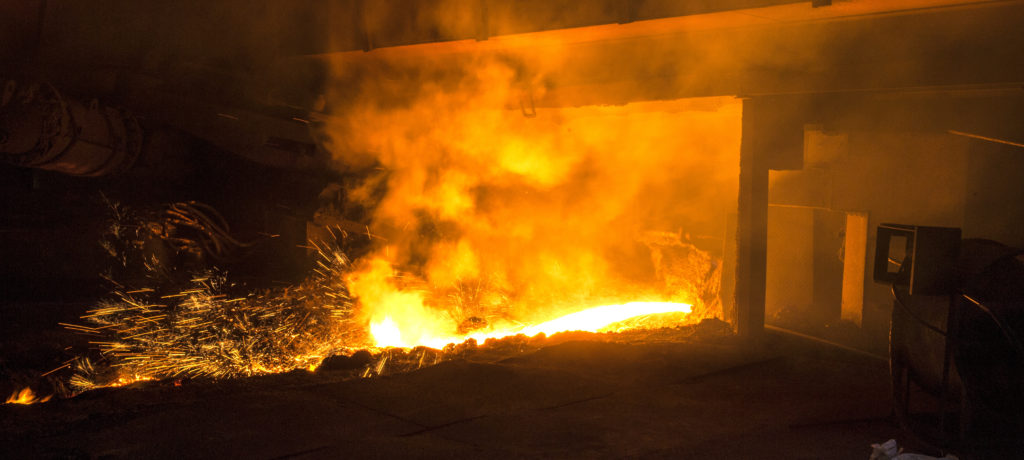
The Climate Cost of Imports
A heavy reliance on imports also has significant environmental costs. When goods and materials are imported to the U.S. from overseas they are often made in less environmentally friendly ways than they would be here at home because they come from countries with lower environmental standards.
For example, materials produced in energy-intensive sectors, such as steel, cement, and concrete, produce a significant amount of greenhouse gas and toxic emissions during the manufacturing process. The global iron and steel industry alone accounts for around 21% of global industrial energy use and 24% of industrial CO2 emissions. [41] These emissions are exacerbated when materials are increasingly imported from more pollution-intensive factories overseas.
Often, products and materials produced overseas are manufactured in ways that would not meet U.S. environmental and emissions standards. The higher emissions from the production of those materials pass through the “carbon loophole,” when imported. Around one quarter of global CO2 emissions are embodied in imported goods, passing through the carbon loophole and escaping any climate or environmental regulation in the United States.
According to a study on the carbon loophole commissioned by the BlueGreen Alliance, after adjusting for the net import of carbon emissions into the United States our progress in reducing CO2 emissions since the early 2000s is nearly wiped away. [42] According to the report, the nation’s domestic production of industrial carbon emissions is only one half of our climate pollution problem. For reference, we imported 1.452 gigatons of CO2 in 2015—twice as much as any other country.
Many of these imported products and materials could be made here in the U.S. by American workers instead of in countries with lower labor, environmental, and health standards. When looking at the entire steel industry, China has the highest energy and CO2 emissions intensities among the countries included in a November 2019 report. [43] The U.S. steel industry’s final energy and CO2 emissions intensities rank 4th lowest among the countries studied. Domestic steelmakers should be rewarded for operating less-polluting mills and not undercut by manufacturers in countries with weak environmental practices.
Researchers from Princeton University found increasing wages for workers in the clean energy sector by 20% would only increase the capital costs of solar and wind projects by 2-4% and operations and maintenance costs by approximately 3-6% across technologies, assuming current domestic content shares.
Making Clean Energy Deliver
These concerns can be addressed and job quality in the clean energy sector can be improved through the enactment of strong policy mechanisms such as labor standards to ensure that jobs being created are high-quality jobs, procurement standards to ensure that investments being made in the clean economy are benefiting workers here in the United States; and manufacturing policies to help ensure we lead in building the next generation of clean technology in America.
Policy Recommendations
Ensure Clean Energy Investments Deliver Good Jobs
Key clean energy tax credits should be extended and strengthened, including those for onshore and offshore wind, solar, clean transportation, grid modernization, and energy efficiency. Congress should also make these tax credits direct pay—many of the companies in this space don’t have taxable income to fully take advantage of these credits and lower-income consumers, in particular, may be unable to gain the benefits of these credits if they aren’t refundable.
At the same time, to ensure that federal investments in clean energy projects deliver quality, family-sustaining jobs and support a robust domestic supply chain, a range of labor, domestic content, and equity standards should be attached to spending on any federally funded infrastructure project, including clean energy projects. This can be done, for example, by tying any direct public support for clean energy projects—either through tax, grants, or loans—to strong labor provisions like Project Labor Agreements (PLAs), prevailing wage, neutrality policies on collective bargaining, “ABC tests” to protect against worker misclassification and wage theft, apprenticeship utilization, labor-management job training programs, community benefit agreements, local hire, targeted hire, and the utilization of domestically-produced materials and components.
Clean energy tax credits are a particularly important part of this conversation given their primary role in driving clean energy investments. Attaching or incentivizing these kinds of job quality and domestic manufacturing conditions is therefore a critical opportunity to shift behavior in these sectors. Policies like these are key tools available to laying a strong foundation for high-quality job creation in the clean energy economy.
We are seeing innovative examples of these policies moving in Congress. For example, Chairman Wyden’s Clean Energy for America Act offers a technology-neutral approach to future energy tax credits, which rewards carbon abated, spurring deployment and innovation of low- and no-carbon technologies, including solar, wind, and nuclear energy. This bill includes requirements for prevailing wage and registered apprenticeship to ensure clean energy jobs are safe and family sustaining and provide competitive benefits. Another bill, introduced in the 116th Congress by Senator Merkley, the Good Jobs for the 21st Century Energy Act, would reward projects that meet a host of labor standards, including prevailing wage, PLA utilization, and others.
There are similar, successful policies at the state level moving across the country. For example, Maryland’s Clean Energy Jobs Act, which opened an application period for up to 1,200 MW of new offshore wind projects and established a process for regulatory review of project proposals, requires any project approved to use a community benefit agreement and pay prevailing wages. [44]
Washington State’s Clean Energy Transformation Act takes steps to ensure job quality by incentivizing labor standards through the use of tiered exemptions from state and local sales tax. [45] The bill ties eligibility for tax credits to the implementation of strong labor standards. For example, to be eligible for a 100% tax remittance, developers of renewable energy projects must have a Community Workforce Agreement (CWA) or PLA.
Invest in Rebuilding U.S. Manufacturing
Policies that increase the demand for clean technology must go hand-in-hand with direct investments to support and grow American manufacturing and domestic supply chains. Already, as the nation increases deployment of clean technology, our ability to manufacture those products and the parts and materials that go into them is falling further behind as demand increases, and other nations move quickly into these markets. [46] That is why smart policies and targeted investments are needed to ensure that the nation is able to capture the benefits of the clean energy economy.
In 2020, the BlueGreen Alliance released a comprehensive manufacturing agenda proposing a set of national actions to achieve global leadership across clean technology manufacturing; cut emissions from the production of essential materials; rapidly upgrade and modernize the entirety of the U.S. industrial base; and undertake a new generation of industrial development that rebuilds good American jobs and is clean, safe, and fair—for workers and communities alike. [47]
To acheive these critical goals, the nation needs to invest at scale to support and grow American clean technology manufacturing and supply chains, and modernize, transform , and cut emissions from energy-intesnive industry.
That means utilizing proven tools to make increased, sustained, and coordinated investments in converting, retooling, or establishing clean technology manufacturing facilities in the United States, such as expanding existing Department of Energy and manufacturing loan programs like the Advanced Technology Vehicles Manufacturing Loan Program, and robustly funding the Manufacturing Conversion Grants program to enable existing facilities—particularly those at risk—to retool to manufacture the next generation of clean technology,
At the same time, DOE should also be funded to make grants and loans at the scale necessary to enable energy intensive industrial facilities of all sizes to rapidly adopt efficiency enhancing and emissions reducing technology; and to enable our largest most critical facilites to deploy globally leading carbon emissions and conventional pollutant reducing technology, while keeping jobs here in the United States.
First, is the Advanced Energy Manufacturing Tax Credit (48C)—a 30% investment tax credit created to reequip, expand, or establish domestic clean energy, transportation, and grid technology manufacturing facilities. The scope of the program can and should be expanded to capture the manufacture of key energy and carbon reducing technologies, such as battery components and emissions reducing technology for industrial facilities. Additionally, the 48C tax credit can be improved by ensuring projects pay prevailing wage and that program funds are targeted to support clean technology manufacturing in communities that have lost jobs in manufacturing, mining, or power generation and other disadvantaged and impacted communities and should prioritize those firms hiring displaced workers. Congress has also proposed similar grant and rebate programs.
Second, new clean energy manufacturing investment and production tax credits are needed that are specifically designed to fill major strategic gaps in clean technology supply chains. We currently lag far behind Europe and Asia in manufacutring the batteries, components, and materiasls that power electric vehicles, we manufacture virtually no offshore wind components, and lack capacity to manufacture huge portions of the solar supply chain.Targeted manufacturing investment tax credits (ITCs)—and grant programs—can complement 48C to facilitate major investments to onshore manufacturing in these sectors. New production tax credits(PTCs)—such as as recently introduced PTC for key segments of the solar supply chain—will be critical to create a durable incentive for domestic production of strategic clean energy and vehicle component technologies and to expand operations to a globally-competitive scale quickly and sustainably.
Expanding Workers’ Rights and Power
According to the Economic Policy Institute, “the bottom 90% of the American workforce has seen their pay shrink radically as a share of total income” from 58% in 1979 to 47% in 2015. [48] That is a loss of almost $11,000 per household. There is a direct correlation with the decrease of worker power over this time, as the share of workers in a union fell from 24% in 1979 to less than 11% now. [49]
Pro-worker policies at the federal level are critical to expanding unionization in the clean energy sector and beyond. This can begin with passage of the Protecting the Right to Organize (PRO) Act. [50]
The PRO Act is designed to ensure workers can band together to negotiate better wages and safer working conditions.The bill would end prohibitions on collective and class action litigation; prohibit employers from permanently replacing striking employees; amend how employees are defined to ensure that no one is misclassified as an independent contractor; strengthen remedies and enforcement for employees who are exercising their rights; create a mediation and arbitration process for new unions; protect against captive audience meetings; and streamline the National Labor Relations Board’s procedures.
Additionally, job quality is more than just good pay and benefits. A high-quality job is a safe job, and—if the jobs created in the clean energy sector are to be high-quality jobs—they therefore must also be safe jobs. Unfortunately, high-profile cases of unsafe work environments in this sector are not unusual. For example, the ongoing safety issues at Tesla’s gigafactory are well known. [51] A 2017 report found that Tesla’s total recordable incidence rate was 31% higher than the automobile manufacturing industry as a whole. [52] However, Tesla’s injury records are also notably questionable. Investigations have found the company delaying reporting injuries until after the 6 month period the U.S. Occupational Health and Safety Administration (OSHA) has to file citations. OSHA previously had 5 years to do so under the Obama administration’s “Volks” Recordkeeping Rule, which was overturned by the Trump administration. [53,54] This delayed reporting has allowed Tesla to get off the hook for endangering workers. Essentially, weak reporting standards allow employers to avoid being cited for their higher injury and illness rates. Even while gaming the system, Tesla has racked up more violations than the 10 other biggest automotive companies in the United States combined. [55]
There are a number of measures that can be taken to improve worker safety. Perhaps most importantly, union representation in the workplace can help more workers feel confident that they can report unsafe working conditions without fear of retribution, and provide mechanisms for doing so. We can see examples of this from the ongoing COVID-19 pandemic, during which unionized workers have reported feeling more able to speak up when faced with unsafe working conditions. [56] To that end, passing legislation like the PRO Act could have a positive impact on worker safety.
Impacts of Good Jobs and Domestic Manufacturing in Clean Energy
Now we are left to ask: What would the impact of these policy recommendations be? What would happen if clean energy workers were paid more? What if more clean energy components were manufactured in the U.S.? Would this drive up costs for renewable technology, making it harder to reach the goal of achieving net-zero greenhouse gas emissions by 2050? The answer, it turns out, is that we would see significant benefits for workers and communities without any significant impact on costs or deployment of renewable energy.
Impact on Clean Energy Deployment
Researchers from Princeton University found increasing wages for workers in the clean energy sector by 20% would only increase the capital costs of solar and wind projects by 2-4% and operations and maintenance costs by approximately 3-6% across technologies, assuming current domestic content shares. [57]
Those small technology cost increases may very well be offset by an increase in labor productivity as a result of the wage premium increase. For example, a 20% labor cost premium may be offset by an increase in domestic labor productivity by 20%. Studies have found that projects with PLAs see fewer cost overruns, thanks at least in part to the stabilizing effects of PLAs. [58] Other studies have found that the volatility of the construction industry causes a constant loss of human capital, and more stable career paths and training offered by high-road contractors can mitigate this [59] and that deaths on the job are more common in states with more low-road contractors. [60] This can manifest in real ways for the effectiveness of projects. In energy efficiency for example, studies report a significant gap between the expected and realized energy savings of various efficiency measures, and this in part is attributable to poor quality work. [61]
The researchers from Princeton also found the impact of increased domestic manufacturing for clean energy to be similarly minimal, with a 10% increase in domestic sourcing associated with only a 1% increase in project costs for solar PV projects.
When looking at the impact that increasing the wages of clean technology workers would have on the total cost of transitioning to a clean energy system, again, the Princeton researchers found that the impact was very minimal, determining that there is only a 3% difference in supply-side investment cost over the entire transition period from 2020 to 2050. They also found these costs would have no recognizable impact on deployment of clean energy. The research makes clear that the need to move quickly to deploy clean energy technology is not a valid line of reasoning for neglecting job quality considerations in the industry.
Benefits for Workers and Communities
While increasing wages and the amount of domestic content in the solar and wind energy industries will have a very minimal impact on project costs, workers in those industries would see significant benefits, including billions in higher wages and hundreds of thousands of new jobs in the 2020s. The researchers found paying workers 20% more and increasing the use of domestic content would generate an additional $5 billion in annual wages in the 2020s, which equates to increasing each worker’s average annual wages by over $10,000. And by producing more of these components here in the United States, we can support an additional 45,000 jobs in the 2020s and an additional 95,000 jobs in the 2040s.
Equity and Justice
Achieving equity in the clean energy economy requires addressing racial injustice head on. Historically—and persistently—Black Americans fare worse in the economy, having lower wages, less savings to fall back on, and significantly higher poverty rates as systemic racism has stacked the deck against people of color. [62] Regardless of education level, Black workers are far more likely to be unemployed than white workers. In fact, historically, unemployment rates are twice as high for Black workers. That disparity carries into the workplace as well, with Black workers paid on average 73 cents to the dollar compared to white workers. [63] The wage gap persists regardless of education, and even with advanced degrees Black workers make far less than white workers at the same level. The poverty rate for white Americans sits at about 8.1%, for Black households it’s 20.7%. [64]
One of the most powerful tools at our disposal in the fight for equity is unionization. Research has shown that through the collective bargaining power of unions, workers are able to get more and better benefits—such as health insurance and pensions—and are able to fight for more enforcement of the labor protections they have a right to under the law, like enforcement of safety and health regulations and overtime. [65] Moreover, research has shown that across the board union members earn higher wages than non-union workers and the difference is most pronounced for workers of color and women: [66]
- White, male union members earn 17% more in wages on average compared to white male non-union workers;
- Female union members earn 28% more in wages on average compared to non-union female workers;
- Black union members earn 28% more in wages on average compared to non-union Black workers; and
- Latino union members earn 40% more in wages on average compared to non-union Latino workers.
Increasing union density in the clean energy sector is a key way to address the inequity inherent in our economy. However, the labor movement has grappled with a history of racial exclusion. Therefore, as we work to grow clean energy jobs in this country, we must ensure that we are not only ensuring those are good union jobs but that they are accessible jobs. We need to support and grow pathways into good, union jobs in these and other sectors for workers of color and other segments of the population historically left out of these occupations.
There are many policies that can help ensure the jobs created in the clean economy are created where they are needed most—including low-income communities, communities of color, and deindustrialized communities. Policies like the PRO Act that create good, union jobs and ensure community benefits, particularly for targeted constituencies, are a powerful force to reduce the income inequality that has harmed the American middle class and build a competitive clean energy economy. We take a deeper look at some additional policies below.
Registered Apprenticeship, Pre-Apprenticeship Programs, and other Union-Affiliated Training Programs]
One of the main mechanisms for building career pathways is through registered apprenticeship, pre-apprenticeship, and other union-affiliated training programs. Here too, strong unions can play a key role in promoting diversity. A BlueGreen Alliance analysis of DOL’s Registered Apprenticeship Partners Information Database System (RAPIDS) found that in the construction industry 43% of apprentices were people of color in union programs compared to 33% people of color in non-union programs.**
Pre-apprenticeship programs in particular have become a key tool to improving diversity in the building trades. [67] Such programs aim to ensure that workers can qualify for entry into an apprenticeship program and have the skills they need to succeed. These programs are generally designed to target certain populations or demographics such as low-income workers, workers of color, or women. For example, the HIRE360 program in Chicago, launched in 2019, is working to provide greater access to careers in the trades to women and minority communities. [68] Among its services, the program works to improve completion rates for apprentices.
At a national level, North America’s Building Trades Unions (NABTU) sponsors Apprenticeship Readiness Programs (ARPs) that prepare local residents, especially women, people of color, and transitioning veterans, to be successful in registered apprenticeship programs. [69] Their report on Diversity and Inclusion Initiatives illustrates state-level successes achieving diversity in apprenticeships. [70]
Additionally, many unions offer training throughout a member’s career to enable them to stay up to date with the industry. For example, the International Union of Painters and Allied Trades offers career-long training through its Finishing Trades Institute. [71]
Project Labor Agreements (PLAs) and Community Workforce or Benefit Agreements (CWAs/CBAs)
PLAs, as previously discussed, are collective bargaining agreements that are negotiated in advance of a project. Community Workforce Agreements (CWAs) and Community Benefit Agreements (CBAs) are beneficial tools for communities when included in PLAs. They can be more expansive in scope, and are sometimes negotiated with both union and community partners. According to the AFL-CIO, CWAs, “go well beyond the traditional experience and use of PLAs” to “explicitly address the legitimate needs and interests of urban communities that have historically been excluded from the benefits of economic development.” [72] In addition to the collective bargaining aspects of a PLA, CWAs frequently include local hire provisions, targeted hire of low-income or disadvantaged workers, and the creation of pre-apprenticeship pathways for careers on the project.
Local Hire
Local Hire provisions mandate or incentivize the hiring of workers from within the state or local community. Without this provision, work crews from out of state can be brought in, minimizing the job creation benefits for the local community. Local hire provisions may mandate a certain percentage of local workers be used, they may offer incentives to hire local workers, or they may simply require that local employment impacts are considered alongside other benefits of projects being evaluated.
Targeted Hire
Targeted Hire provisions—often a key feature of CWAs—mandate or incentivize the hiring of workers on a project from certain communities, which may include women, people of color, veterans, the formerly incarcerated, indigenous people, economically disadvantaged communities, communities heavily impacted by climate change or climate change policies, and many others. These communities may be targeted through contracting requirements, hiring requirements, or the use or establishment of pre-apprenticeship programs. Ideally, these provisions establish long-lasting pipelines for members of disadvantaged communities to access good jobs and careers in the clean economy.
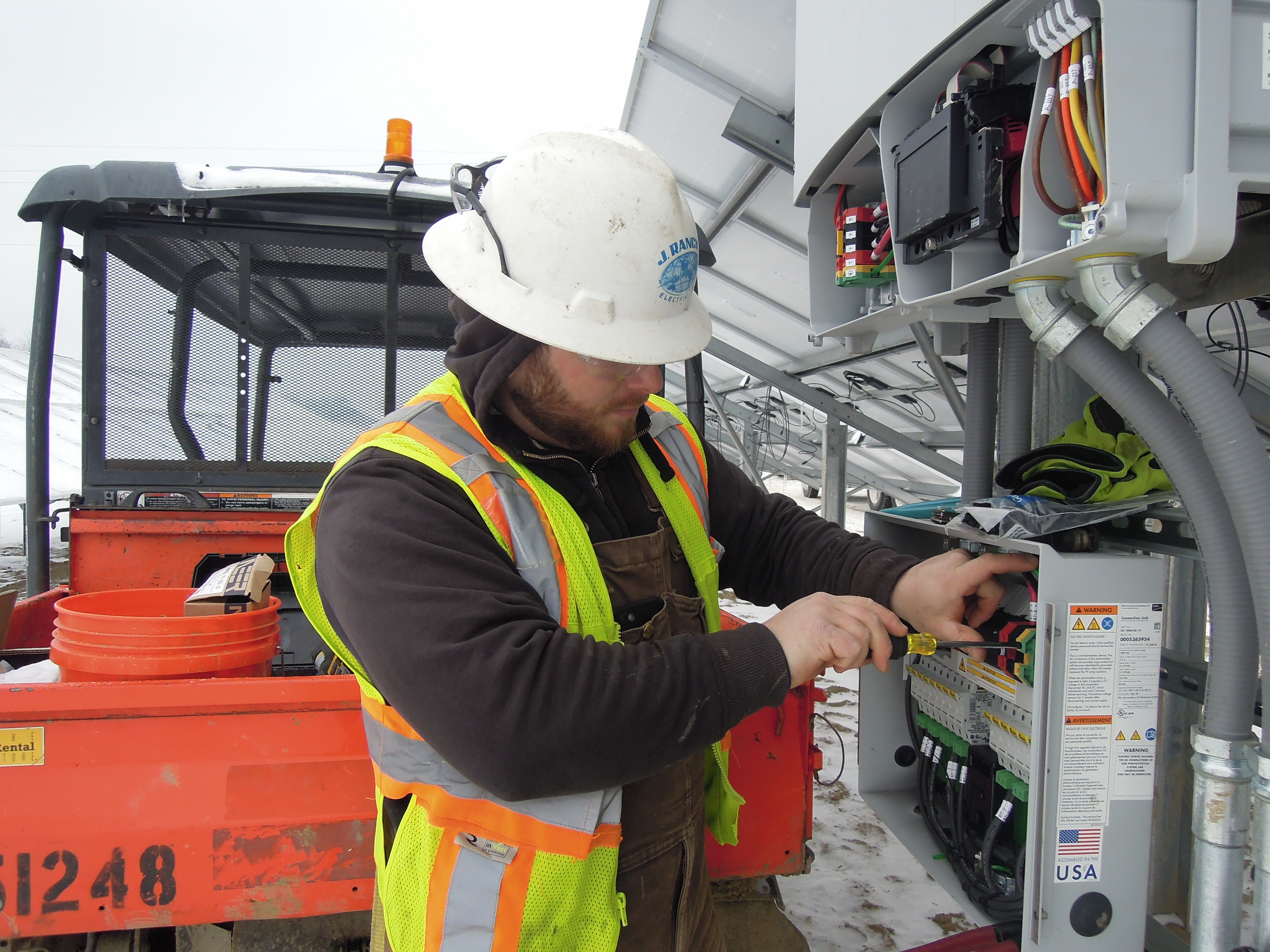
Conclusion
As the U.S. ramps up efforts to grow the clean energy sector, it is not enough to simply invest in renewable energy and EVs. While these investments are critical to preventing the worst impacts of climate change, we must—at the same time—move forward with the right policies in place to lift up the quality of the jobs created and ensure workers and communities see the full benefits of these investments.
Not enough of the jobs in the clean energy sector are good-paying, union jobs. As a whole, clean energy jobs pay less than traditional energy generation jobs. Through federal policy, we can make the important strategic investments in clean energy projects needed to address the climate crisis in ways that ensure the jobs created are good jobs and that the investments deliver gains for American manufacturing, for workers, and for communities—particularly disadvantaged communities and workers. Raising wages in the sector will have a minimal impact on clean technology costs and deployment, while providing clear benefits to workers and communities.
Additionally, along the manufacturing supply chain, the nation has not taken full advantage of the opportunity to grow good jobs producing the parts and materials needed to keep our transition to cleaner, cheaper forms of energy moving forward.
Ensuring strong labor and domestic content standards go hand-in-hand with federal investments in clean energy projects—and are coupled with additional policies to support domestic manufacturing and workers’ rights—are just some of the ways to help address these issues and ensure momentum on those fronts.
Finally, investing in the clean energy economy the right way will not only help address the climate crisis, but can also fight the interconnected crises of income inequality and racial inequality. Increasing union density and utilizing union apprentice and pre-apprenticeship programs, and ensuring equitable access to these jobs can serve to build pathways into good-paying careers in the clean energy sector for workers of color.
Job quality in the nation’s clean energy sector is not where it should be, but with the right policies, it can get there and the U.S. can build a clean, thriving, and equitable economy.
_____
Additional Notes
*Sources differ on the unionization rate of the coal industry. While the CPS finds that 9.6% of Coal Mining workers are covered by a union contract, the 2020 USEER reports only 1% of the Coal Fuels sector is union. The higher number is more in line with estimates reported in the media and by the Energy Information Administration, but it should be noted that there is significant uncertainty around this estimate.
**This analysis is based on the DOL RAPIDS data extract through FY 2020 Q4. Programs were analyzed only in the 40 states where RAPIDS has high-quality data; CT, MA, MN, NM, NY, NC, OR, VT, WA, and WI were excluded. Construction industry apprenticeship programs classified as such by NAICS code. To determine the union affiliation of apprenticeship programs, 501(c) subsections from the IRS Exempt Organizations Business Master File Extract (EO BMF) were added to the RAPIDS data based on EIN. Programs were determined to be union-affiliated if they were sponsored by a 501(C)(5) organization or if their organization type in the RAPIDS database was “Union/Labor”; programs were determined to be nonunion if they had a valid organization type other than “Union/Labor”; and non-501(c)(5) programs with no valid organization type were excluded from the analysis. Apprentices of color were those whose race was recorded as anything other than “white” or ethnicity was “Hispanic”; those with missing race or ethnicity were excluded from the analysis.